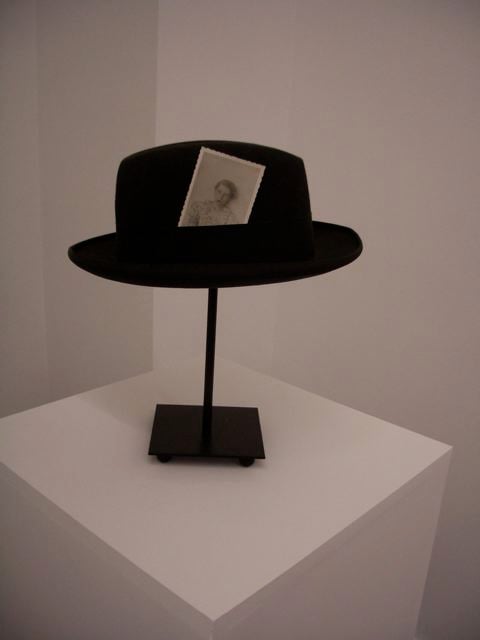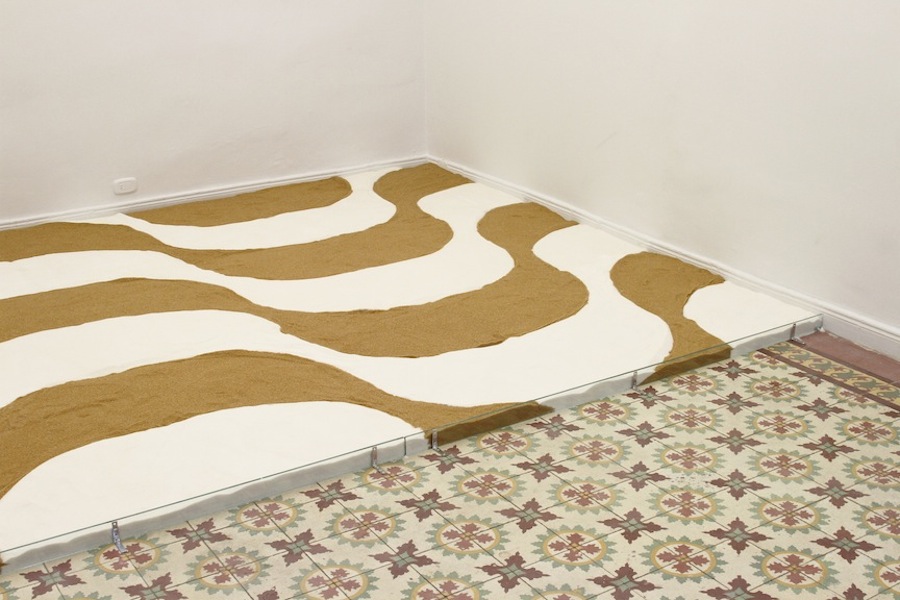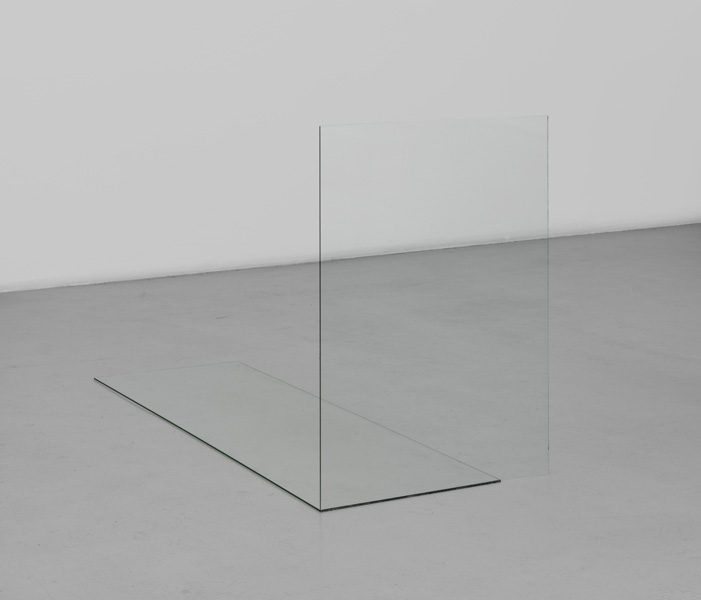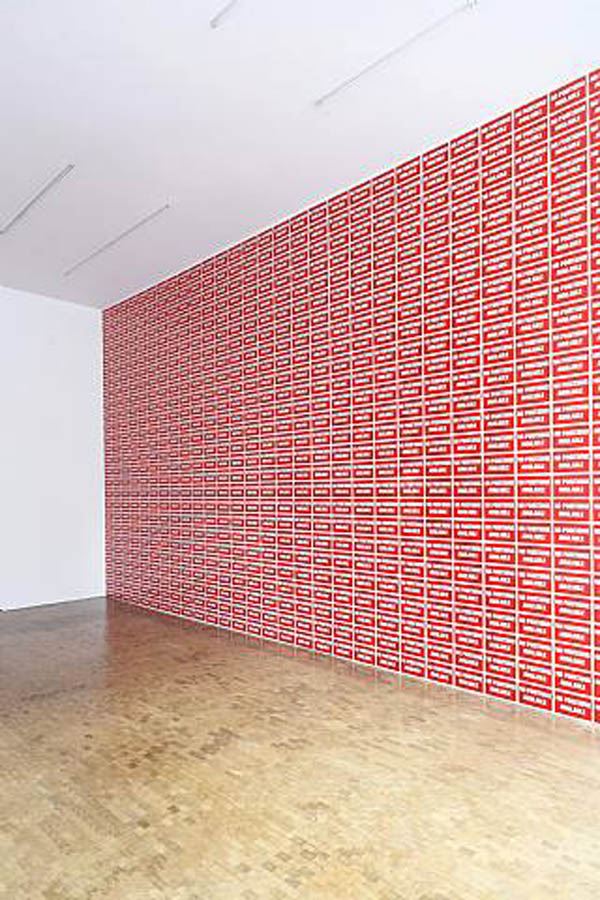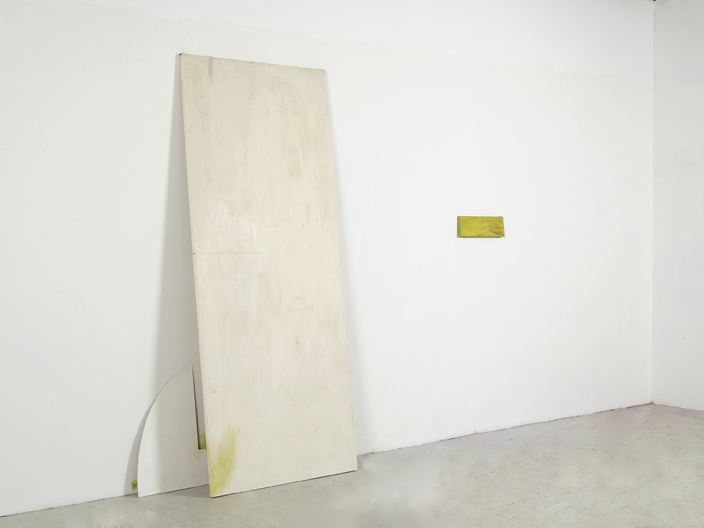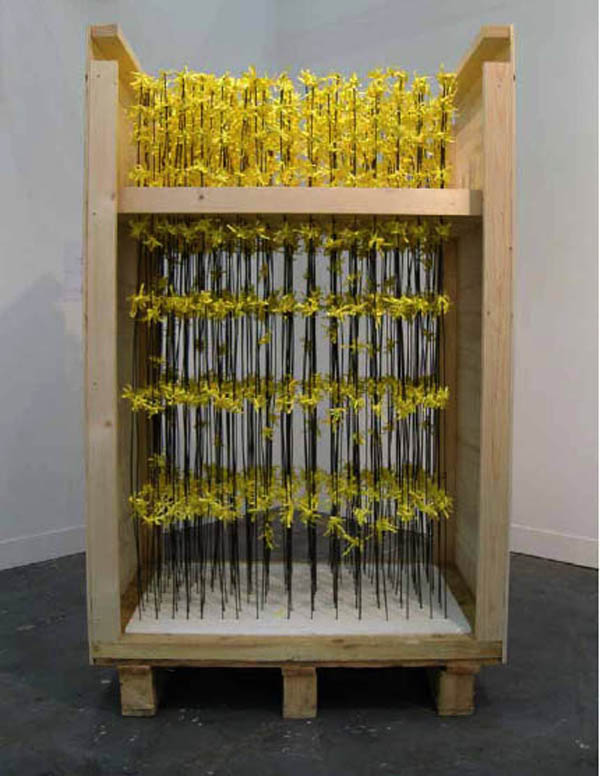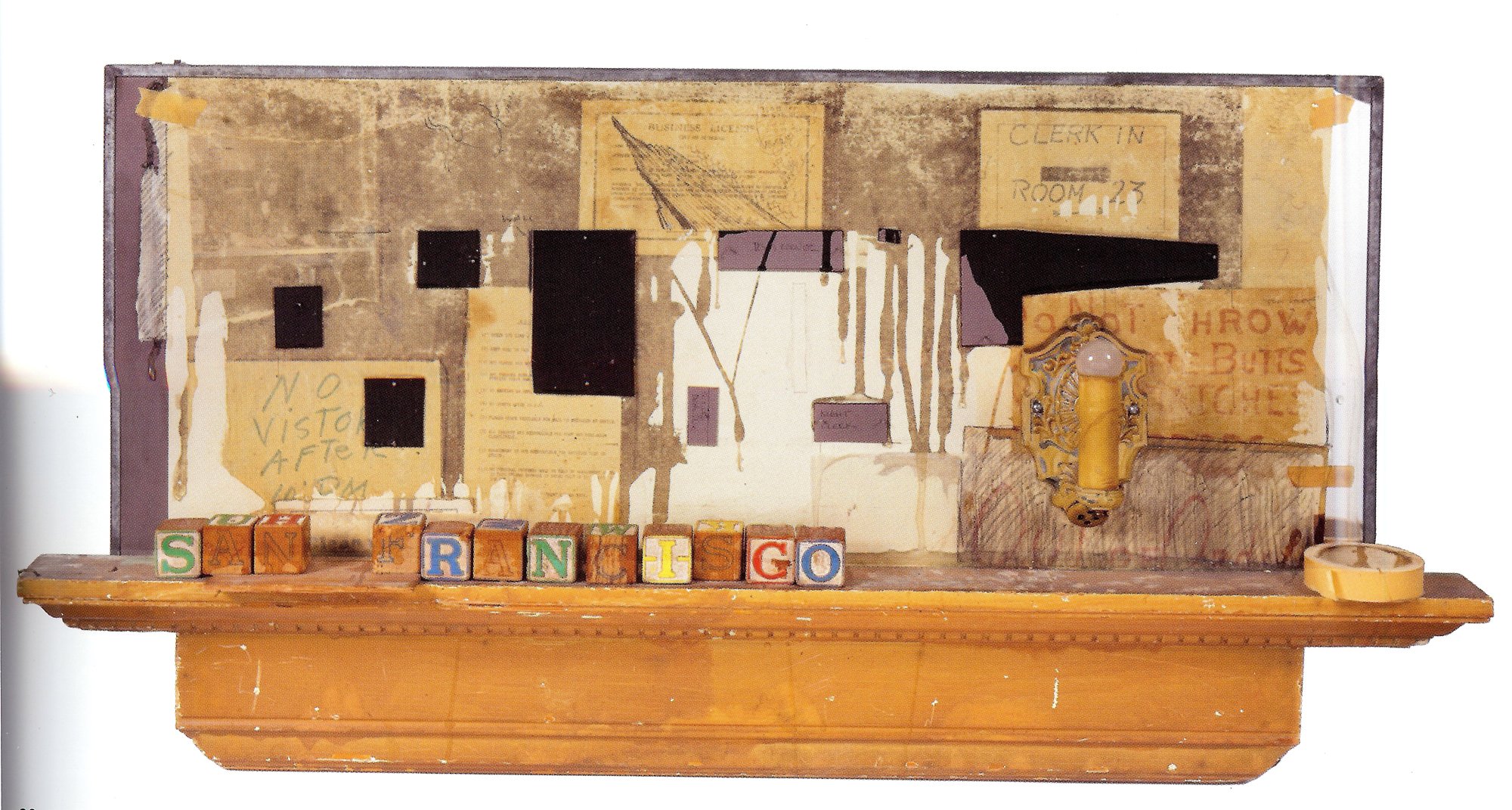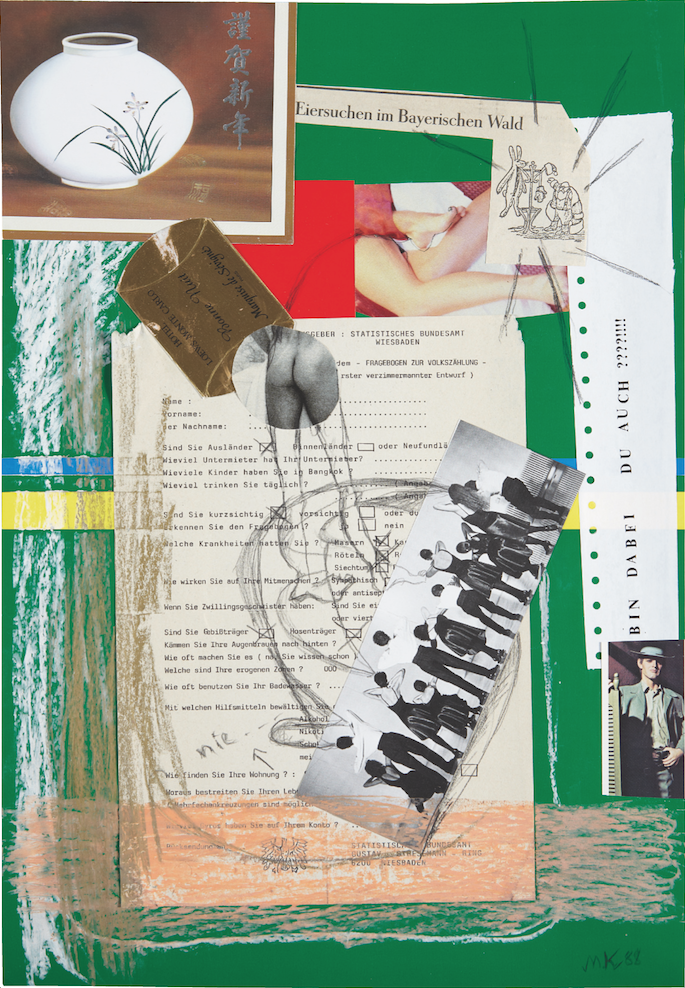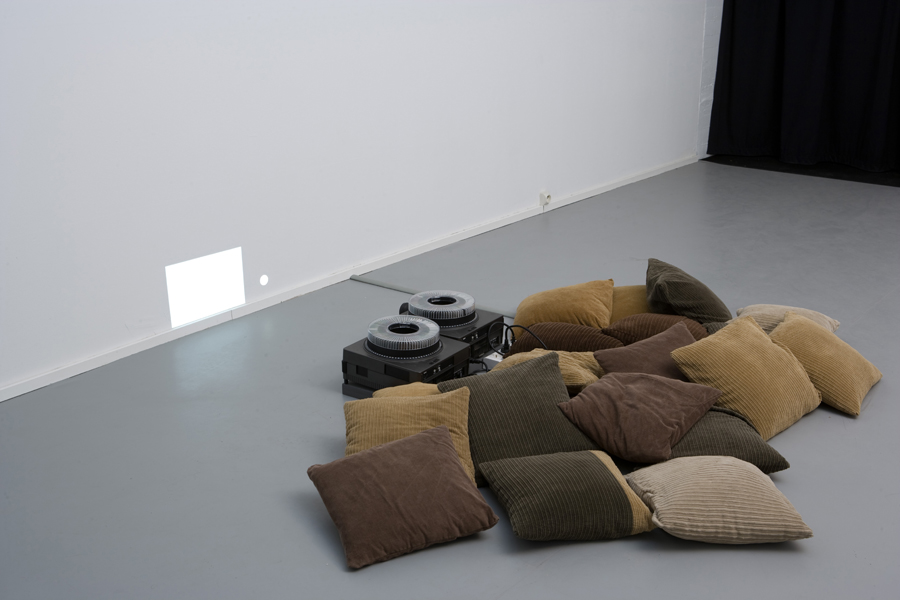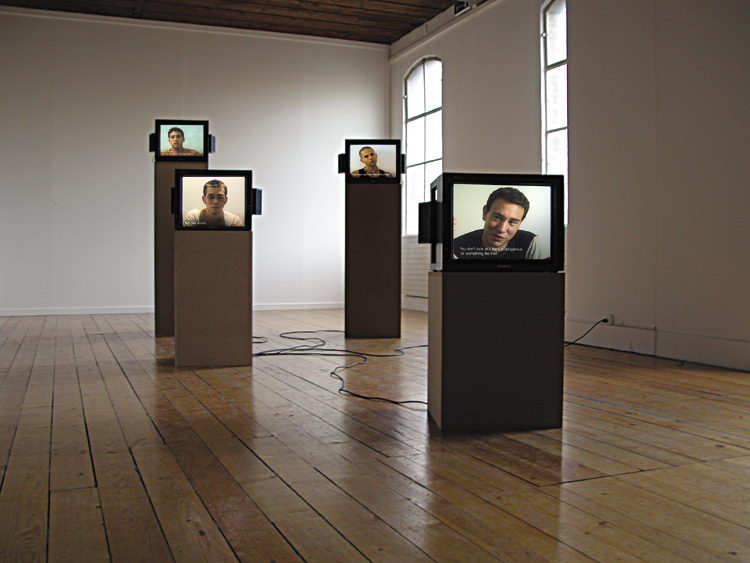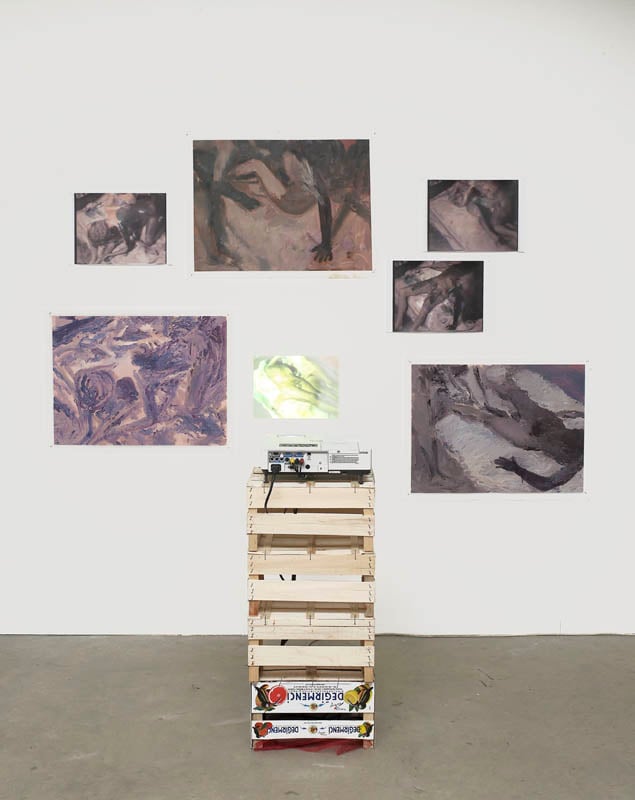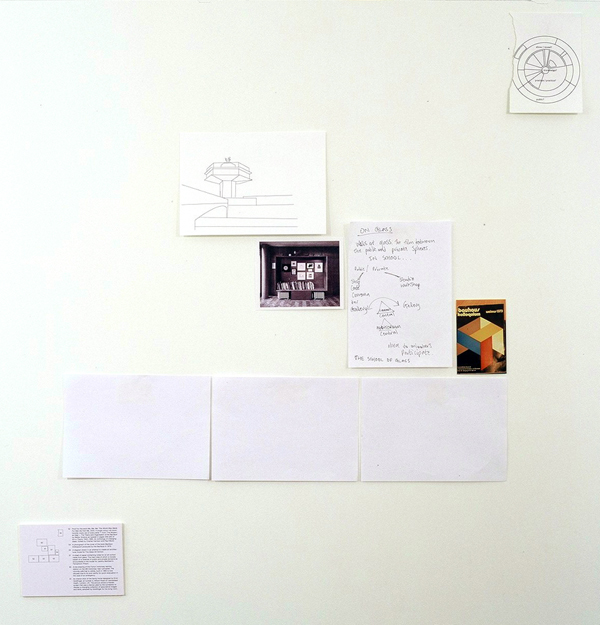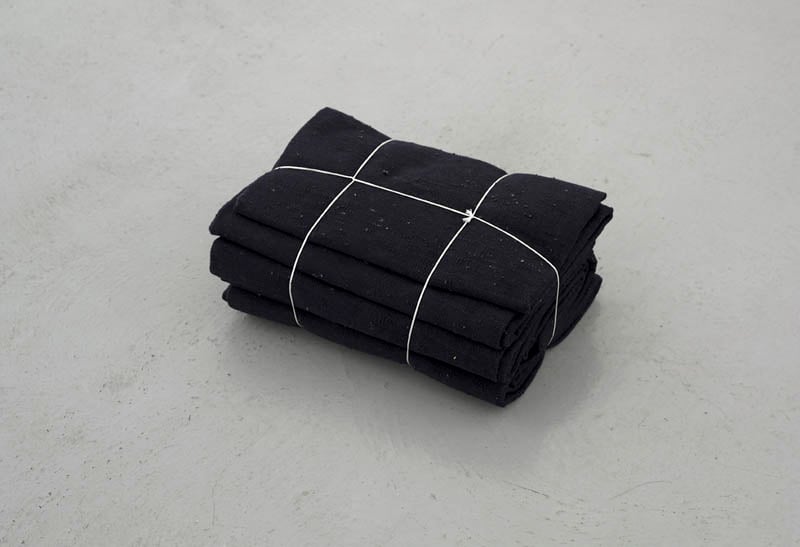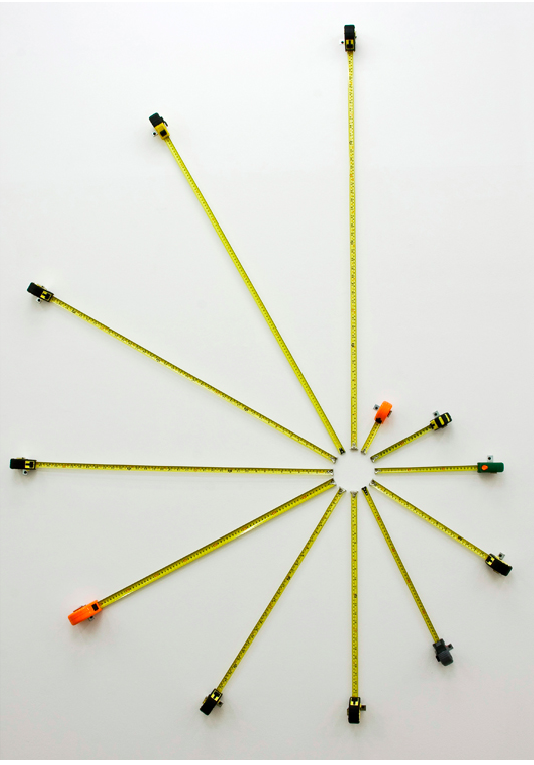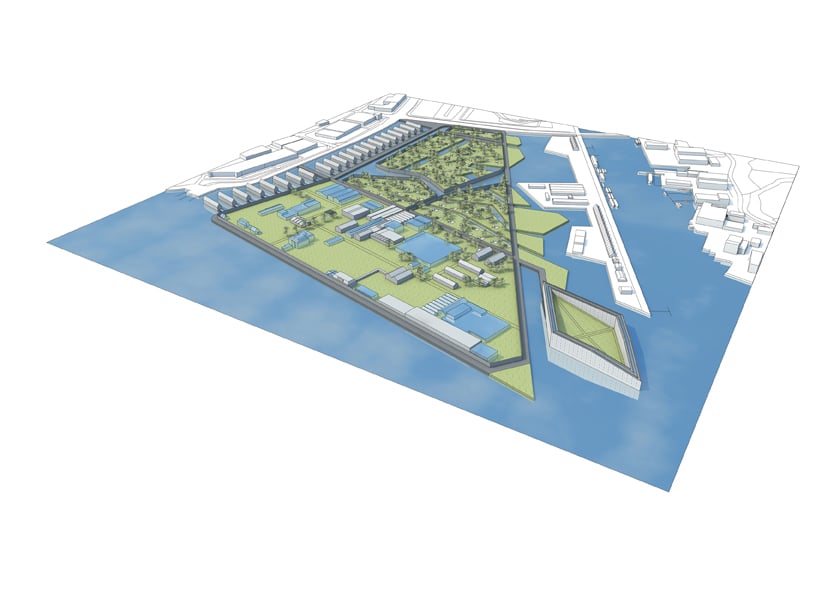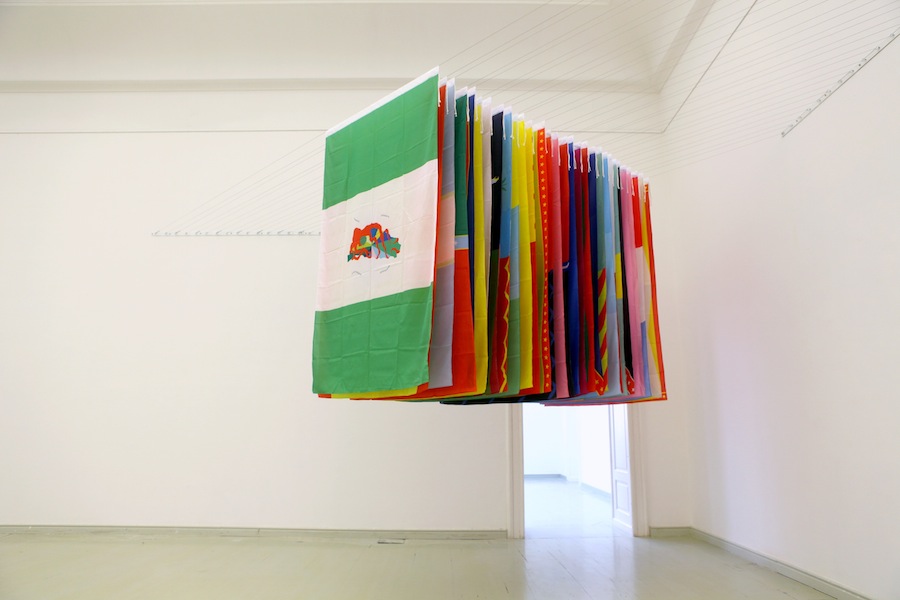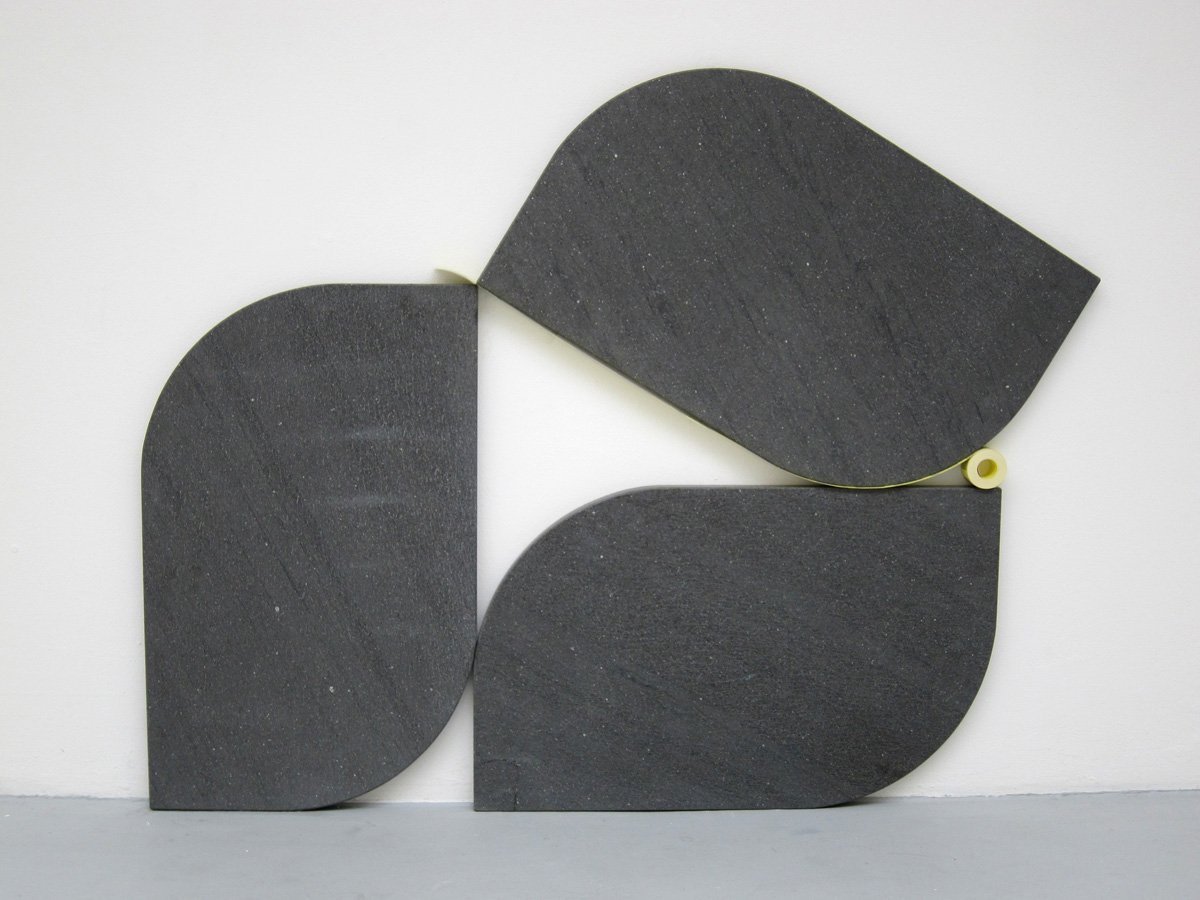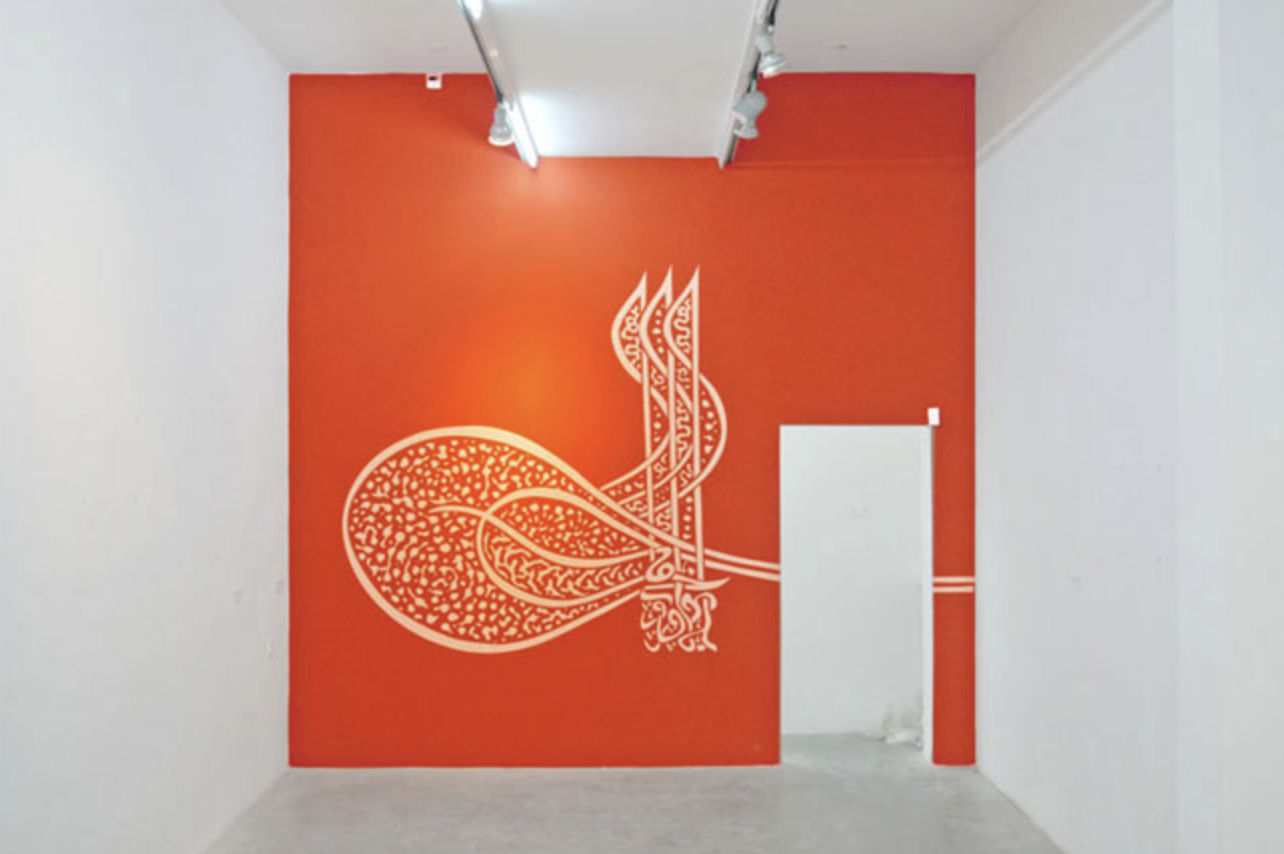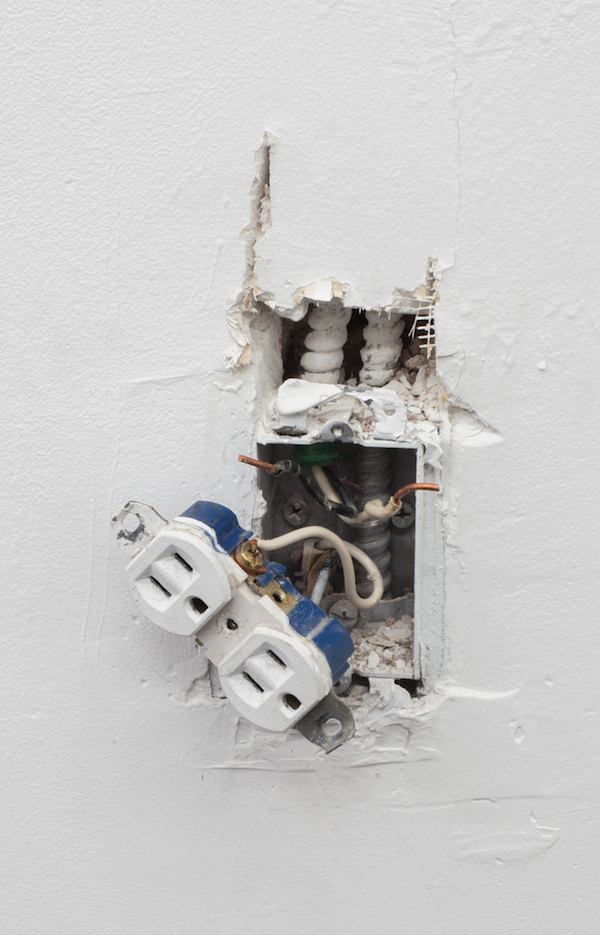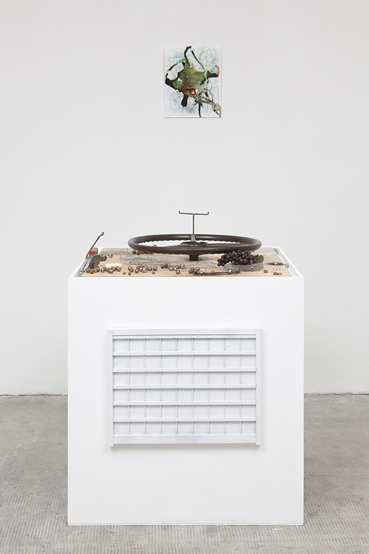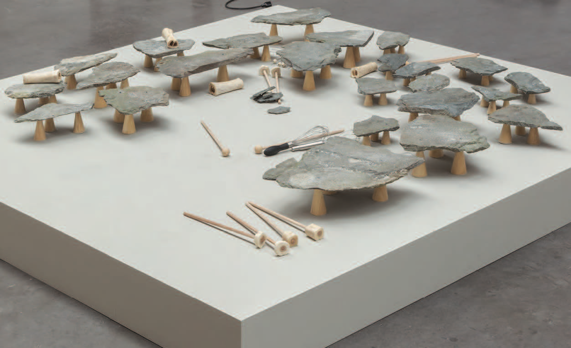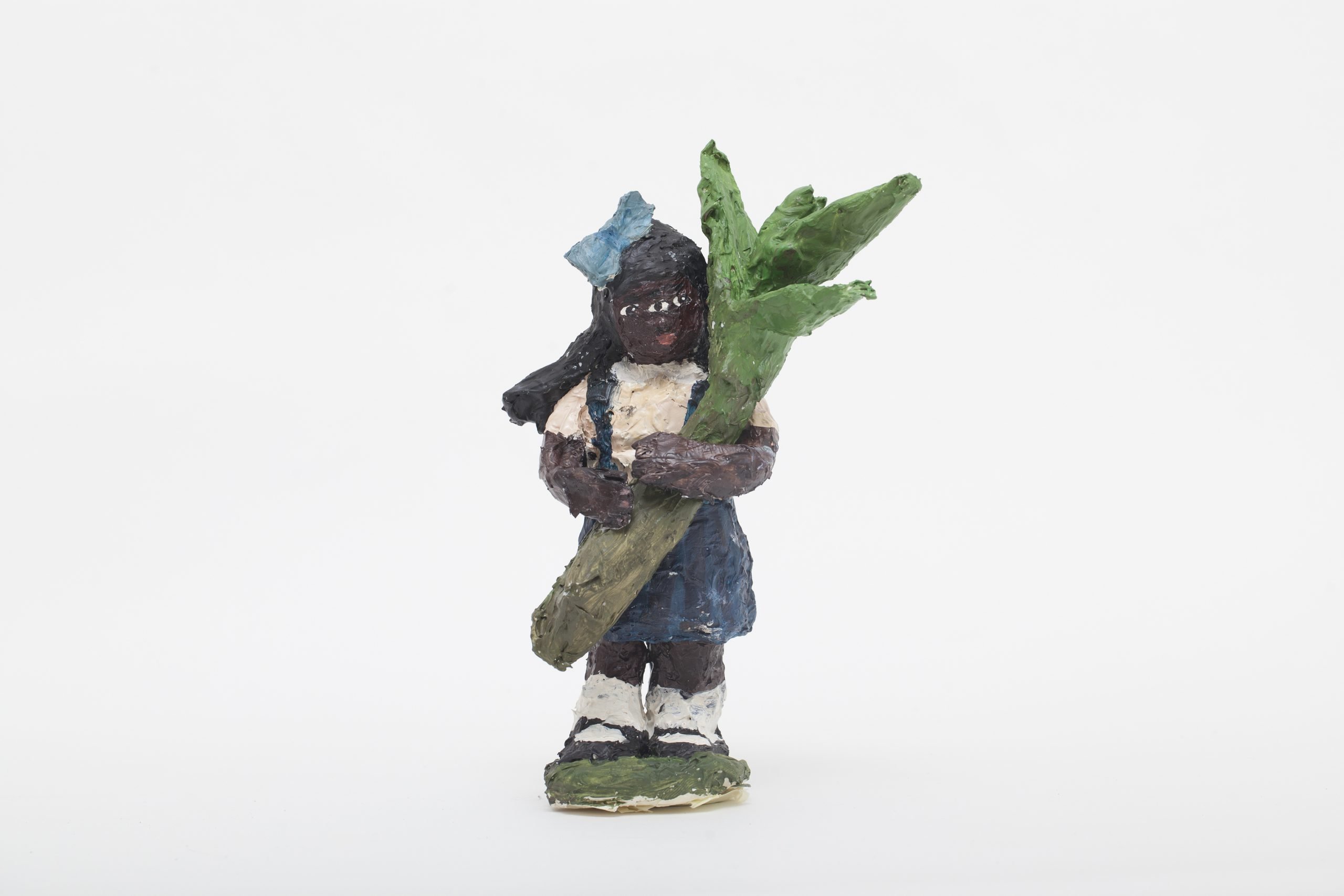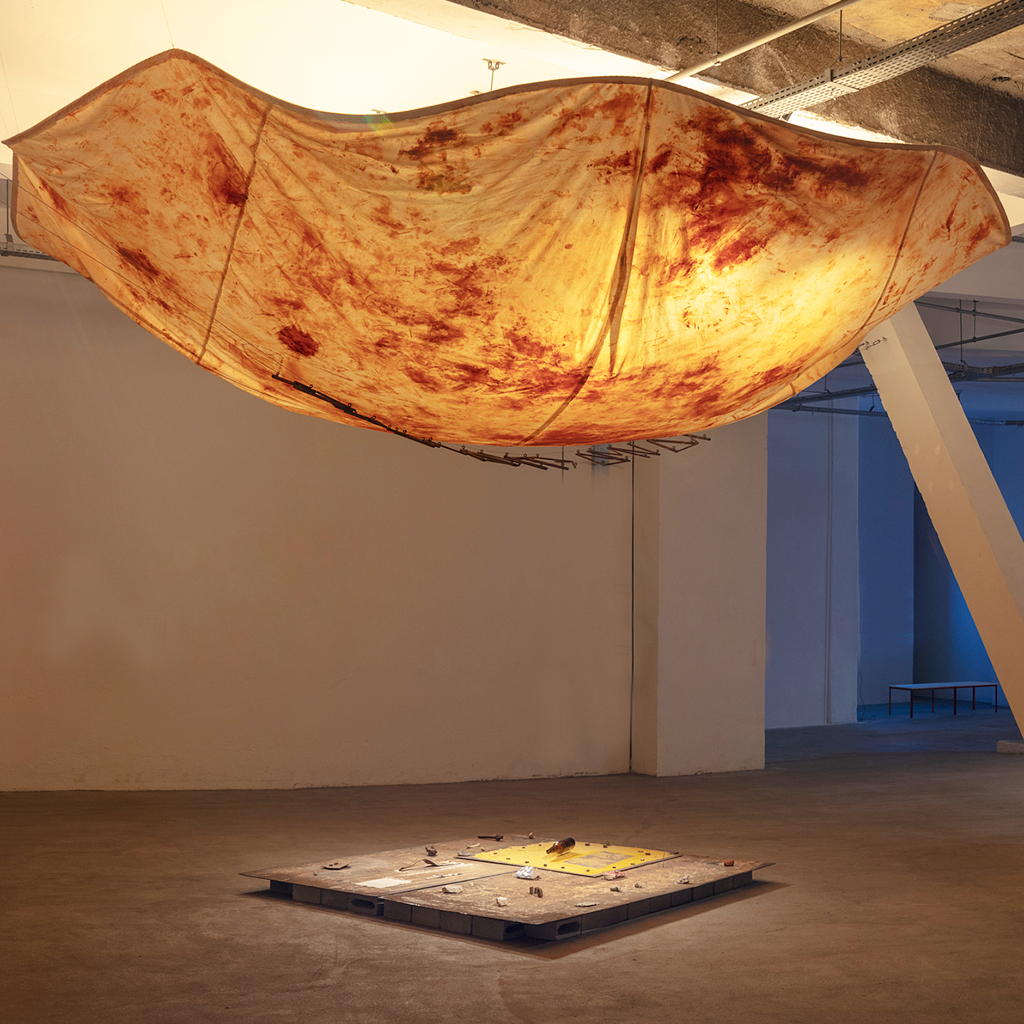
© » KADIST
Diamond Stingily
Dad is Byron is an audio work produced in collaboration between Diamond Stingily and her father, the house musician Byron Stingily. Viewers are invited to pick up a wall-mounted telephone that has been retrofitted to play a recording of a conversation between Stingily and her father. Although initially the artist planned to focus on her father’s recollections of the violence during his childhood in Chicago in the 1960s and how music helped him cope, the conversation has a natural and intimate meandering.

© » KADIST
Lutz Bacher
Sweet Jesus is a sound installation by Lutz Bacher that consists of a found recording of James Earl Jones’ iconic voice reciting biblical genealogy from Matthew, Book 1. Lutz has edited the recording by slowing it down slightly and adding background sound from the same recording. In Lutz’s edit, these are all the names of the ancestors of Jesus leading up to Joseph, but she leaves Jesus out of it, then reverses chronologically.

© » KADIST
Hitesh Vaidya
In the process of creating this deeply personal body of work, titled Recollecting Memories , artist Hitesh Vaidya repeatedly visited the site of his ancestral home that was destroyed during the devastating earthquakes in Nepal in 2015. Through meticulous paintings on salvaged debris, artefacts, and memories, Vaidya navigates the trauma of being uprooted and re-examines his relationship to a fractured past. This aspect of this installation includes various materials from the artist’s former home, including wooden beams and pillars, door and window panels, stone, and floor and roof tiles.

© » KADIST
Clarissa Tossin
In Fordlândia Fieldwork (2012), Tossin documents the remains of Henry Ford’s rubber enterprise Fordlândia, built in 1928 in the Brazilian Amazon to export cultivated rubber for the booming automobile industry. When his rubber trees died from disease and his primarily indigenous workforce revolted, his enterprise went busts within a few short years. Ford never faulted his own planning, but instead blamed the “inhospitable” Brazilian landscape.

© » KADIST
Aura Satz
For her telephone sound composition Dial Tone Drone, Aura Satz commissioned a conversation between two old friends, the sound pioneers Pauline Oliveros (1932-2016) and Laurie Spiegel (born 1945). Carried out via iPhone and Skype and prompted by a series of questions from Satz, the pair congenially discuss aspects of drone sounds, which for years have been an important component of their unconventional electronic work, both audio and video. Their interest in drone sounds and use of sustained or repeated sounds, notes, or tone-clusters aligned with Satz’s own interest in alert signals, and the latter’s attempt to forge a new understanding of hypervigilance and emergency through sound as a perceptual trigger of high alert.
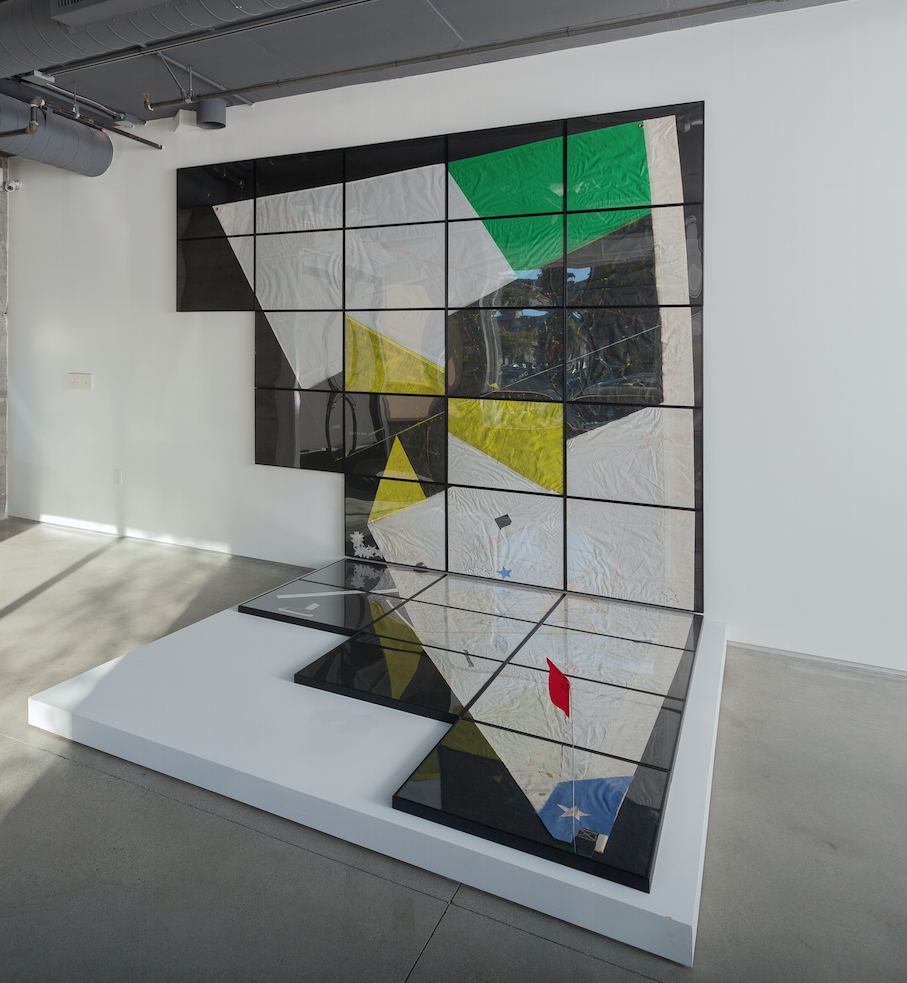
© » KADIST
Enrique Ramirez
Ramirez’s The International Sail is the fifth in a series that features an upside-down worn out, mended and fragmented boat sail. These works epitomize the idea of perpetual movement and migration while carrying a deep personal meaning in the creative process, as the artist’s father himself, still living in Chile, mends and sends the sails to his son, living in Europe. The reversed position of the sail recalls both the shape of South America itself and the Eurocentric view that in the Southern Hemisphere, everything is “upside-down.” The stitches themselves create an illusion of an alternative political geography, and the framed-cuts impose a cartographic grid.
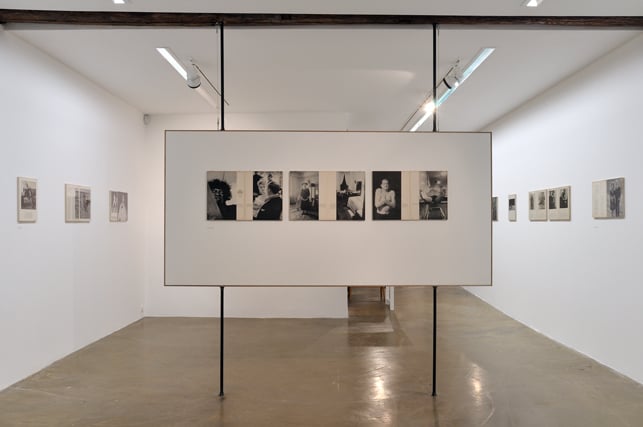
© » KADIST
Pierre Leguillon
End of 2008, Pierre Leguillon presented at KADIST, Paris the first retrospective of the works of Diane Arbus (1923-1971) organized in France since 1980, bringing together all the images commissioned to the New York photographer by the Anglo-American press in the 1960s. This exhibition, destined to tour in various locations, presents the original pages of the magazines, including “Harper’s Bazaar”, “Esquire”, “Nova” and “The Sunday Times Magazine”. As Pierre Leguillon states: “The mythology surrounding Diane Arbus’ character is willingly set aside to offer a more neutral point of view on a more unfamiliar part of her work, although it was mass-distributed.” Many of the characters portrayed in these commissioned works seem less sensational at first glance than the “freaks” that made Diane Arbus’ work so famous, since the retrospective MOMA organized in 1973 in New York, two years after her suicide.

© » KADIST
Pablo Pijnappel
In Felicitas, we follow the converging routes of three characters: Felicitas, Michael and Andrew (the artist’s father-in-law who also features elsewhere). Felicitas is thedaughter of a German industrialist who immigrated to Rio after the Second World War. She is the one visible with a toucan in several images.

© » KADIST
Liu Chuang
Categorized as low-level literature, a “Love Stories” book is a romantic popular fiction of proletariat China, read mainly by teenagers, students, and young workers. These novels were mostly written by Taiwanese and Hong Kong writers in the 1980s to the 1990s to meet the cultural needs of the new social classes before being imported into China after the Chinese economic reform in the late 1980s. As contemporary China industry developed, a large number of workers became readers of this new pulp fiction.

© » KADIST
Elisheva Biernoff
In her recent work, Biernoff is interested in investigating fictions and fantasies embedded in the remnants of consumer culture (for example magazines) or through ephemera such as postcards and old photographs. Although the imagery present in her work might seem nostalgic upon first encounter, Biernoff’s complex tableaux often reveal the artist’s skeptical look towards her subjects matters. They Were Here (2010), constitutes a clear example.
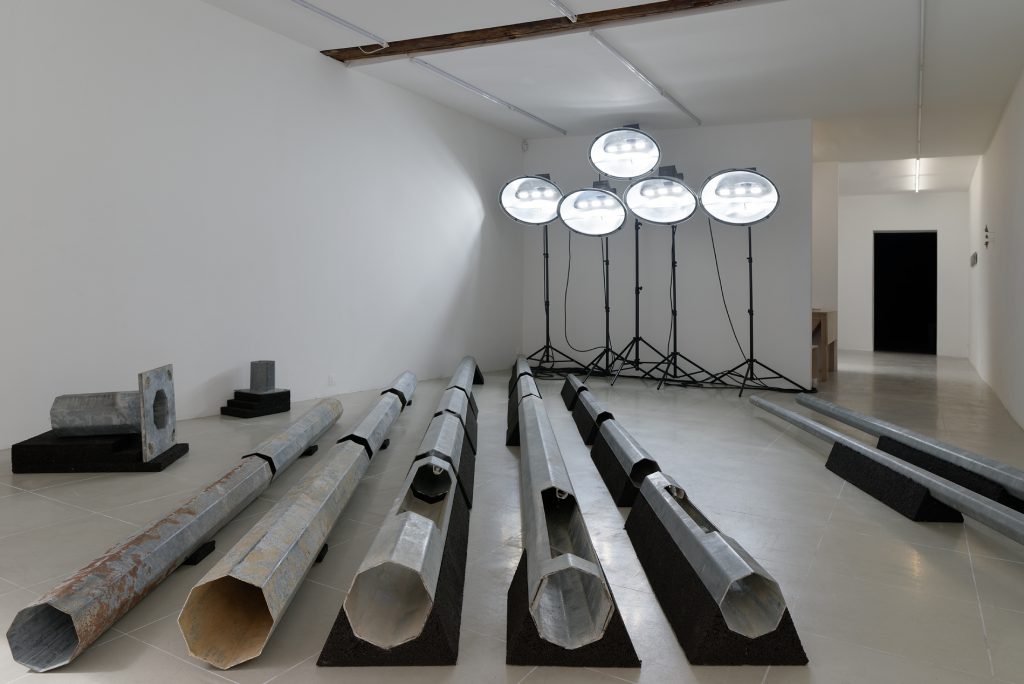
© » KADIST
Haig Aivazian
For the exhibition 1440 sunsets per 24 hours at KADIST Paris in 2017, Haig Aivazian presented a sprawling installation, which sought to enact various instances of the deployment of light and darkness within public space and sports, reflecting on the double-edged abilities of lighting systems to expose, highlight or dissimulate subjects. For the installtion 1,2,3 soleil ! the space was structured like a material index, posing limbs and skins from stadiums and public spaces —namely floodlights, electric poles and asphalt— alongside abstract drawings inspired by policing and sporting data visualization iconography.

© » KADIST
Nicolás Consuegra
A residency program in the blazing hot city of Honda, Colombia, inspired artist Nicolás Consuegra to consider the difficulty in understanding the needs of a distant community. An important town during the colonial era as the main port on the Magdalena River, Honda is presently rife with poverty, unemployment, and environmental deterioration. Here he produced the work Nadie sabe de la sed con que otro bebe (No one knows the thirst with which another drinks) , a variable arrangement of cut glasses in front of a mirror so that they appear whole.

© » KADIST
Chemi Rosado-Seijo
Map of the Universe from El Cerro continues Chemi Rosado-Seijo’s long-term engagement with the community of El Cerro , a rural, working-class community living in the mountains of Naranjito, Puerto Rico. The project was initiated in 2002 by painting the exteriors of residents’ homes different shades of green, paying homage to the way the community has been built in harmony with the topography of the mountains where it stands. Through negotiation and collaboration with community leaders, volunteers, students and residents, over 100 homes have been painted.

© » KADIST
Christoph Keller
Message to the Extraterrestrials consists of a slide projector beaming images into the side of the telescope. These are then reflected down to a mirror at the bottom of the telescope and from there to a mirror on the ceiling. From the ceiling the images bounce down to a mirror at floor level which projects the images through an open window to the world outside.

© » KADIST
Peter Friedl
Peter Friedl’s projects place aesthetic questions within an expanded field that takes into account the social, political and philosophical context. This textile piece quotes and diverts a flag with a red background and the central star of the Kurdistan National Liberation Front (ERNK, a military organization linked to PKK, founded in 1985 and disbanded in 2000), and not the national flag of Kurdistan. The artist became interested as from 1994, when the town of Lice was destroyed by the Turkish army and the PKK was expelled from Germany.
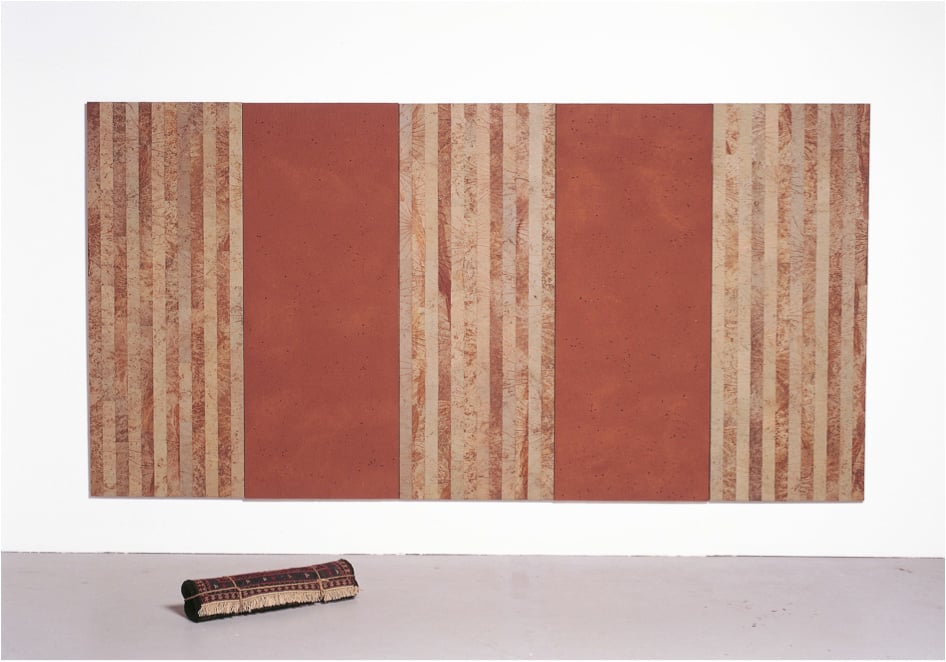
© » KADIST
Hossein Valamanesh
In Runner there are two elements:a big painting and a rolled Persian rug. The rug refers to Iran’s cultural history. The travelling tribes used to transport rugs through the desert on camels or horses so that they would always have a comfortable place to sleep and dream.

© » KADIST
Valeska Soares
Relying on repetition and repurposed materials, Soares works to interrogate time—its measurement, its passing, and its meaning. With copper wire stretched out across the room like a clothesline, Valeska Soares’ La Ligne du Temps creates a timeline out of fluttering, old book pages. Read upon the pages of this delicately wrought installation are linguistic approaches to time and its phenomonologies.
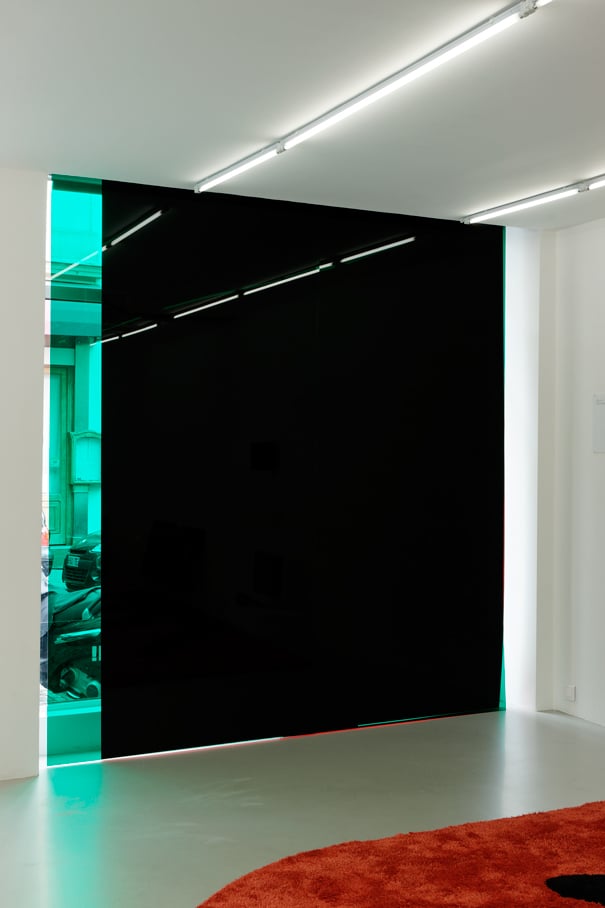
© » KADIST
Rossella Biscotti
In a broader sense, the meaning of ‘blackout’ —primarily an electrical failure or momentary interruption, opens up to new organizations, perceptions and different ways of experiencing time and space. Every person caught in a blackout must redefine the potentiality of public space, relate to strangers and invent new temporary forms of organization. A blackout acts as the breaking point of an established order, on a personal level as a loss of consciousness or on a collective level, as the temporary disruption of political institutions for example.

© » KADIST
Jesse Chun
O (for various skies) by Jesse Chun is a two-channel video sculpture that decentralizes American colonial narratives about the moon through “unlanguaging”—a methodology that the artist has conceptualized for unfixing language. The project disrupts bureaucratic documents pertaining to the United States government’s lunar colonization and militarization, such as The Lunex Project of 1958 and Project Horizon of 1959, through methods of visual, semiotic, and sonic (mis)translation and abstraction. Chun redacts the found texts, transforming them into concrete poetry, while interweaving lesser known Korean folklore about the moon, such as the precolonial Korean women’s moon dance ( ganggangsullae ) and shamanistic ritual dance for ushering the departed into another world ( gildakeum ).

© » KADIST
Otobong Nkanga
Tsumeb Fragments was produced for the exhibition at Kadist, “Comot Your Eyes Make I Borrow You Mine” in 2015. In Spring 2015, Nkanga travelled to Namibia, making her way along an almost entirely defunct railway line from Swakopmund to Tsumeb. The artist was intent on reaching The Green Hill in Tsumeb, an area renowned for its minerals, crystals and copper deposits.

© » KADIST
Rometti Costales
Canción para un fósil canoro (Song for a chanting fossil) by Rometti Costales is inspired by the history of the building that currently hosts the Museo de la Solidaridad Salvador Allende (MSSA) in Santiago, Chile. The duo associated the layers of the building’s history with the vestiges of life and the processes of fossilization that have taken place in areas of the Atacama Desert, a territory that has been the stage for several episodes in Chile’s tumultuous economic and political history. The work operates as a metaphor for the strata of historical memory, condensing different materials and operations.

© » KADIST
Loris Gréaud
The acronym “CFL” stands for an existing light standard (Compact Fluorescent Light) as well as a standard nutrient (Cognitive Fooding Laboratory). “CFL” is a mobile laboratory for growth of watercress shoots which contain high levels of anthocyanin – a natural pigment used by fighter pilots to increase their visual acuity at night in order to achieve better responses to light stimuli. In the work Celador, a taste of illusion (2007), the viewer is invited to consume the plants – a candy with the flavor of illusion.

© » KADIST
Sylbee Kim
Sylbee Kim’s Unindebted Life is a single-channel video, commissioned and premiered at the 13th Gwangju Biennale (2021). This work is a major production by the artist, addressing her attempts to attractively integrate and intersect elements such as bodies and minds, ancient spirituality, heterogeneity, class and capital, digital temporality, and particular aesthetics of the post-internet generation. In the work, the vitality and the movement in calligraphy motifs, revealed through the flashing light presented in the screen panels and video sequences, are related to the moment of change inherent in the body’s cell energy and living things.

© » KADIST
Indira Allegra
Open Casket IX is an installation by Indira Allegra that combines traditional materials of memorial—tombstones, mausoleums, and caskets—with contemporary expressions of grief. The work is a memorial for people who have lost loved ones to police violence. It is part of Allegra’s Open Casket series, which is concerned with the need to recognize grieving as a collective responsibility, rather than an individual misfortune to be shouldered by one affected person or family.

© » KADIST
Eduardo Navarro
The installation Breathspace by Eduardo Navarro encompasses all the content presented at the artist’s first solo exhibition, of the same name, at Gasworks, UK. In lockdown, Navarro started drawing every day and this practice “relocated the studio to inside his head”. This meditative activity was inspired by quantum physics, according to which information in the universe cannot be created nor ever destroyed.
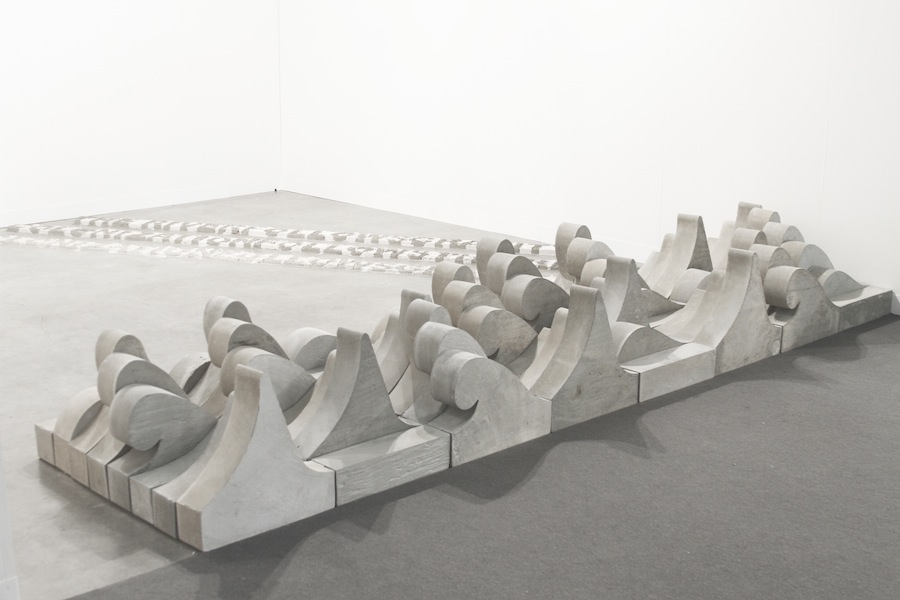
© » KADIST
Felipe Arturo
Primero estaba el mar ( First Was the Sea , 2012) is a system of equivalences between syllables and silhouettes of waveforms cast in cement. Each waveform represents a syllable of the sentence “Primero estaba el mar.” This sentence is the first verse of the Kogui poem of creation. For the Koguis, an indigenous community from the Sierra Nevada de Santa Marta on the Colombian Caribbean coast, water was the absolute presence before the creation of the universe.

© » KADIST
Yuji Agematsu
Each day, Yuji Agematsu smokes a pack of cigarettes and wanders the streets of New York City looking for trash. Needless to say, he finds it everywhere: bottle caps, gummed hair, translucent miscellany, sick feathers, hot pink plastics, unknown, and more. The varied bits are then constellated by the artist in cellophane cigarette wrappers—modest vitrines for his steady collecting habit.

© » KADIST
Claire Fontaine
Foreigners Everywhere is a series of neon signs in several different languages. Named for Stranieri Ovunque, an anarchist collective from Turin, the work embodies and projects the ambivalence of their name into various sites and contexts. Lacking context, the neon suggests a factual statement, xenophobic threat, and evokes the estrangement of feeling foreign in a global society, a circumstance legible by the targeted populations.

© » KADIST
Kelly Sinnapah Mary
Notebook 10 , l ‘enfance de sanbras (The Childhood of Sanbras) series by Kelly Sinnapah Mary is a sequel to an earlier series by the artist titled Cahier d’un non retour au pays natal (2015). This earlier work considers the process of reconstructing an identity of the Indian workers who arrived in the Caribbean during the post-slavery period. The work addresses the conditions of recruitment of these Indian workers, the strategies of the recruiters, how they lured them onto ships to bring them back to the plantations.

© » KADIST
Corey McCorkle
Corey McCorkle’s 2016 installation Pendulum is developed around the Cavendish family and their role in importing bananas to Europe. Cavendish bananas were named after William Cavendish, the 6th Duke of Devonshire. In 1834, Cavendish received a shipment of bananas from Mauritius, and developed these bananas in the greenhouses of Chatsworth House with his gardener Sir Joseph Paxton, and were later given to missionary John Williams to take to Samoa.
Kelly Sinnapah Mary
Kelly Sinnapah Mary is a multidisciplinary artist who’s work is informed by the diasporic journey of her ancestors...
Ryan Gander
- location: Chester, United Kingdom
- year born: 1976
- gender: male
- nationality: British
Hans-Peter Feldmann
- location: Düsseldorf, Germany
- year born: 1941
- gender: male
- nationality: German
- home town: Dusseldorf, Germany
Pedro Reyes
- location: Mexico City, Mexico
- year born: 1972
- gender: male
- nationality: Mexican
- home town: Mexico City, Mexico
David Horvitz
Although the practice plays a central role in the work of David Horvitz, his work is at the opposite of fine art objects...
Joana Hadjithomas & Khalil Joreige
Joana Hadjithomas and Khalil Joreige collaborate as both filmmakers and artists, producing cinematic and visual artwork that intertwine, spanning feature and documentary films, video and photographic installations, sculpture, performance lectures and texts...
Rossella Biscotti
Departing from social and political history, the work of Rossella Biscotti (b...
Felipe Arturo
- year born: 1979
- gender: male
- nationality: Colombian
- home town: Bogota, Colombia
Anthony Discenza
Since the late 1990s Anthony Discenza’s work has focused primarily on the omnipresence of mainstream media...
Kitty Kraus
Kitty Krauss has a very particular outlook on Minimal and Constructivist Art...
Pratchaya Phinthong
Pratchaya Phintong’s works often arise from the confrontation between different social, economic, or geographical systems...
Mithu Sen
Mithu Sen’s writing is central to her practice, as a poet from West Bengal, a region of great Indian literary history, poetic and visual tropes giving ground to her challenge of semiotics...
Beto Shwafaty
Beto Shwafaty produces installations, videos and sculptural objects...
Kennedy Browne
Formed in 2005, Kennedy Browne is the collaborative practice of Gareth Kennedy and Sarah Browne...
Pascal Grandmaison
Marked by an apparent austerity and meticulousness, Pascal Grandmaison’s works display a disconcerting aloofness from the world, a clearly asserted detachment from reality...
Liu Chuang
Known for engaging socio-economic matters as they relate to urban realities, Liu Chuang proposes different understandings of social systems underlying the everyday...
Ceal Floyer
- location: Karachi, Pakistan
- year born: 1968
- gender: female
- nationality: Pakistani
Frieda Toranzo Jaeger
Many of Frieda Toranzo Jaeger’s works take the triptych format, employed by artists over many centuries to represent religious devotion...
Brody Condon
Brody Conlon is an American (born 1974 in Mexico) based in Berlin...
Hitesh Vaidya
Centering the humble residences of Nepal, Hitesh Vaidya’s practice explores how domestic objects and architectural spaces are signifiers of a community’s shared memory and its ancestry...
Lydia Gifford
Lydia Gifford was born in 1979...
Jesse Chun
Through video, drawing, sculpture, sound, installation, and publications, Jesse Chun’s multidisciplinary practice critically engages with the politics of language...
Mariana Castillo Deball
- location: Amsterdam & Berlin
- year born: 1975
- gender: female
- nationality: Mexican
- home town: Mexico City, Mexico
Native Art Department International
Native Art Department International is a collaborative project created in 2016 and administered by Maria Hupfield and Jason Lujan...
Nguyen Trinh Thi
Nguyen Trinh Thi is a moving image pioneer, not only within the landscape of contemporary art in Vietnam, but also broader South East Asia...
Engel Leonardo
Working with various mediums, from sculpture to installation, site-specific interventions, and readymades, Leonardo Engel addresses issues related to the climate, nature, traditional crafts, architecture, and popular culture of the Caribbean...
Mohamed Bourouissa
Mohamed Bourouissa became known in the 2000s with a series of photographs on young people in the suburbs of Paris...
Martin Creed
- location: Wakefield, United Kingdom
- year born: 1968
- gender: male
- nationality: British
Joe Scanlan
Joe Scanlan became known in the 1990s due to his very particular appropriation of Conceptual art, exploiting two main registers: display on one hand, designating the artwork as a consumable product, DIY on the other, advocating the mobility and adaptability of objects, even their reversibility depending on contexts and usages...
-
-
1980-1989
Edward Kienholz
1984Untitled (San Francisco) was made in Idaho in 1984 and was facetiously dedicated to Henry Hopkins, the then director of the San Francisco Museum of Art who added “modern” to its name...
Martin Kippenberger
1988Martin Kippenberger’s late collages are known for incorporating a wide range of materials, from polaroids and magazine clips to hotel stationery, decals, and graphite drawings...
-
1990-1999
Barbara Bloom
1997In the 1980’s, while browsing Parisian fleamarkets, Barbara Bloom stumbled into an anonymous watercolor (dating to around 1960) in one of Paris’ fleamarkets, probably a study made by an interior designer for a bedroom...
-
2000-2009
Patricia Belli
2000In the mid-1990s, Belli started to create soft sculptures that allowed her to reconnect with manual labor and sewing learned from her seamstress mother...
Peter Friedl
2001Peter Friedl’s projects place aesthetic questions within an expanded field that takes into account the social, political and philosophical context...
Matthew Buckingham
2002Matthew Buckingham presents a narrative directly connected with a highly symbolic site in the United States, the Mount Rushmore Memorial*...
Pascal Grandmaison
2003Solo (2003) is a video exhibited as a video/sound installation depicting shots of drum, voice, guitar, clavier/synthesizer, and a melodica player cut into segmented fragments from the perspective of a studio recording set...
Martin Boyce
2003In the installation Our Love is like the Flowers, the Rain, the Sea and the Hours, Martin Boyce uses common elements from public gardens – trees, benches, trashbins– in a game which describes at once a social space and an abstract dream space...
Loris Gréaud
2004The acronym “CFL” stands for an existing light standard (Compact Fluorescent Light) as well as a standard nutrient (Cognitive Fooding Laboratory)...
Felix Gmelin
2004Ambiguous Gestures takes as its point of origin a film Gmelin discovered in his father’s archive...
Loris Gréaud
2004This work refers to the “Dream Machines”, an experimental object invented by the painter and writer Brion Gysin and the scientist Ian Sommerville, and which is composed of a light bulb with light passing through slits in a rotating cylinder...
Pablo Pijnappel
2005In Felicitas, we follow the converging routes of three characters: Felicitas, Michael and Andrew (the artist’s father-in-law who also features elsewhere)...
Claire Fontaine
2006Foreigners Everywhere is a series of neon signs in several different languages...
Colectivo Tercerunquinto
2006Escultura publica en la periferia urbana de Monterrey is a public sculpture on the periphery of the city of Monterrey...
Laetitia Sonami
2006Although at first the work Sounds of War presents itself with a degree of playfulness and humour, a close inspection reveals its painful undertone...
Christoph Keller
2007Message to the Extraterrestrials consists of a slide projector beaming images into the side of the telescope...
Roni Mocan
2007Roni Mocan’s work Welcome is a floorwork comprised of a grid-like arrangement of doormats that the artist borrowed from the local community, people in his building, and even from participating artists from the exhibition where it was first presented...
Jason Dodge
2007In Algeria, Djidjiga Meffre has woven a fabric with a string, a length equal to the distance from the earth to troposphere...
Ceal Floyer
2007NO POSITIONS AVAILABLE is composed of panels covering the entire wall of the gallery exemplifying one of the tendencies of the artist...
Rivane Neuenschwander
2007Mapa-Mundi BR (postal) is a set of wooden shelves holding postcards that depict locations in Brazil named for foreign countries and cities...
Ahmad Fuad Osman
2007Recollections of Long Lost Memories by Ahmad Fuad Osman is a series of 71 black and white sepia-toned archival photographs that chart, with nostalgia, the social encounters between hierarchies of life in the Malay world...
Joe Scanlan
2007Spring Line is a piece shown for the first time in his solo exhibition at the Institut d’Art Contemporain in Villeurbanne in 2007...
Pierre Leguillon
2008End of 2008, Pierre Leguillon presented at KADIST, Paris the first retrospective of the works of Diane Arbus (1923-1971) organized in France since 1980, bringing together all the images commissioned to the New York photographer by the Anglo-American press in the 1960s...
Marwa Arsanios
2008Carlton Hotel project is the second part of a research on the Carlton, an iconic building of modernist architecture from the 1960s in Beirut...
Nicolas Bacal
2008Nicolás Bacal uses everyday materials to evoke systems in his sculptures and installations...
Pak Sheung Chuen
2008Pak created New York Public Library Projects (NYPLP) (2008) during a residency in New York, using public libraries as exhibition spaces and the books they house as raw materials...
Nicoline van Harskamp
2008The work is a speech composed of excerpts from autobiographies of well-known political characters...
Jonas Staal
2008Jonas Staal’s installation is based on the thesis written by Fleur Agema and titled “Closed Architecture”...
Elisheva Biernoff
2009In her recent work, Biernoff is interested in investigating fictions and fantasies embedded in the remnants of consumer culture (for example magazines) or through ephemera such as postcards and old photographs...
Kennedy Browne
2009Milton Friedman on the wonder of the free market pencil is an installation based on 42 blank pages...
Matthew Darbyshire
2009Matthew Darbyshire has made several Furniture Islands, all of which employ different objects and different color values...
Geoffrey Farmer
2009Ongoing Time Stabbed with a Dagger was Farmer’s first kinetic sculpture that added a cinematic character to an “ever-reconfiguring play presented in real time.” The assembly of various objects and props on top of a large platform constitutes not only a work, but, to a certain extent, a show in itself...
Jao Chia-En
200930 Proposals of Flag explores the relationships between signs, meanings, aesthetics, and nations...
Szabolcs Kisspál
2009Lifesize Draft is the second of two sculptures on a similar theme, the first one being Utopia Battery, (2008)...
Eko Nugroho
2009Nugroho’s installations and performances have their roots in the shadow puppet rituals in Indonesia, particularly the Javanese Wayang tradition whose essence is in the representation of the shadows...
Pratchaya Phinthong
2009Phinthong provided 5,000 Euros to exchange for Zimbabwean dollars, the most devalued and worthless currency in the world...
Mario Ybarra Jr.
2009Ammo Bunker (2009) is a multipart installation that includes large-scale wall prints and an architectural model...
-
2010-2019
Gabriel Kuri
2010Gabriel Kuri has created a series of works in which he juxtaposes perennial and ephemeral materials...
Zarouhie Abdalian
2010The first iteration of Flutter was specifically conceived for the Pro Arts Gallery space in Oakland in 2010, viewable from the public space of a sidewalk, and the version acquired by the Kadist Collection is an adaptation of it...
Marcelo Cidade
2010Adição por subtração 4 (Addition by Subtraction, 2010) is an intervention into the white cube with both beautiful and intimidating results...
Anthony Discenza
2010A Viewing (The Effect) by Anthony Discenza is a continuous voiceover loop intended for presentation in a dedicated, light-and-acoustically controlled space...
Goldin+Senneby
2010In this installation, you are standing at the heart of a bicephalous space reflecting Goldin+Senneby’s main research led during their residency in Paris...
Lydia Gifford
2011Lydia Gifford composes her work between pictorial expression and its inscription within an exhibition space...
Chitti Kasemkitvatana
2011Mo(nu)ment / (…) / mem(y)orial (2011) is one of the artist’s first artworks after his retreat as a monk...
Jompet Kuswidananto
2011Third Realm (2011) grew out of the artist’s long-term research of Indonesia’s colonial history and the processes of modernization and urbanization that have taken place there...
Phi Phi Oanh
2011Palimpsest is a series of what artist Phi Phi Oanh calls “pictorial installations”...
Natasha Wheat
2011Wheat’s work is built on a strong conceptual framework that weaves together commentary on social and political issues and the radical potential for change...
Taiyo Kimura
2011In Permanent Laughter (2011), dozens of portable compasses are scattered under a sheet of acrylic board, which is in turned covered with what appear to be the diffuse remains of an unidentified skeleton...
Ei Arakawa and Sergei Tcherepnin
2011Part of a series entitled “Looking at Listening”, 2011, the piece invited the spectator to experiment and consider sound as a kinetic and synesthetic process, where multiple experiences and senses can cross...
Sergio De La Torre
2011This is not in Spanish looks at the ways in which the Chinese population in Mexico navigates the daily marginalization they encounter there...
Clarissa Tossin
2012In Fordlândia Fieldwork (2012), Tossin documents the remains of Henry Ford’s rubber enterprise Fordlândia, built in 1928 in the Brazilian Amazon to export cultivated rubber for the booming automobile industry...
Nicolás Consuegra
2012A residency program in the blazing hot city of Honda, Colombia, inspired artist Nicolás Consuegra to consider the difficulty in understanding the needs of a distant community...
Valeska Soares
2012Relying on repetition and repurposed materials, Soares works to interrogate time—its measurement, its passing, and its meaning...
Felipe Arturo
2012Primero estaba el mar ( First Was the Sea , 2012) is a system of equivalences between syllables and silhouettes of waveforms cast in cement...
Nicholas Mangan
2012Executed in 2012, A World Undone revolves around a single, metaphorically rich substance, drawing on geological research into an ancient mineral, Zircon, unearthed in remote Western Australia...
Ryan Gander
2012Epiphany…learnt through hardship is composed of a bronze sculpture depicting the model of the little dancer of Degas, in the pose of a female nude photographed by Edward Weston (Nude, 1936) accompanied by a blue cube...
Nandan Ghiya
2012The Chair (2012) foregrounds media-based tensions between analog and digital imaging technologies as a means of challenging the continued circulation of visual ephemera from India’s colonial past...
Pedro Reyes
2012Pedro Reyes’s Los Mutantes ( Mutants , 2012) is composed of 170 plates that combine characters from ancient and modern mythologies...
Dora Garcia
2012KLAU MICH is a TV and performance project by Dora García with Ellen Blumenstein, Samir Kandil, Jan Mech, TheaterChaosium, and Offener Kanal Kassel, during the 100 days of dOCUMENTA (13)....
Tom Nicholson
2012Tom Nicholson’s Comparative Monument (Palestine) engages a peculiar Australian monumental tradition: war monuments that bear the name “Palestine”...
Felipe Arturo
2012Defined as entropy, the second law of thermodynamics proposes that energy is more easily dispersed than it is concentrated...
Ícaro Lira
2012Icaro Lira has been developing the project “Museum of the Foreigner” since 2015, in which he recounts the trajectories of populations inside Brazil, from the north to the big cities of the south...
Brody Condon
2012Future Gestalt re-imagines a large-scale sculpture “ Smoke” by Tony Smith as embodying a futuristic intelligence that communicates with a group of communitarians undergoing experimental psychotherapy...
Amol k Patil
2012The title of the performance video work Impression by Amol k Patil refers to an Indian tradition...
Yang Zhenzhong
2012Peasant Sensation Passing Through Flesh – 3 consists of a massage chair fixed to a wall...
Heman Chong
2012The work Calendars is composed of 1001 images of deserted public areas in Singapore printed on pages of a calendar set from the year of 2020 until 2096...
Anthony Discenza
2012In Anthony Discenza’s 23-minute audio loop that makes up A Rising Tide Lifts All Boats , a nondescript male voice narrates a series of unlikely pairings: “think Dune meets South Pacific;” “think dubstep meets the Magna Carta;” “think the Food Network meets Igmar Bergman.” Given without inflection or emotion, this recitation uses the structure of a Hollywood elevator pitch to sketch out an unknown project, idea, or structure, conflating and collapsing cultural referents into an implausible mass of contradictions....
Daniel Steegmann Mangrané
2013In the hologram “Mano con hojas” (”Hand with Leaves”, 2013), nature is portrayed simultaneously as an interconnected system of processes and the essence of the universe...
Nora Schultz
2013Halfway between a painting and an installation City Sound of Rug gathers found images, synthetic foam, painted metal plates, and prints placed on the floor...
Sharif Waked
2013Tughra is a protocol by Sharif Waked that reproduces the sixteenth century calligraphic monogram for tughra ; also known as the signature of Suleiman the Magnificent...
Phan Thao Nguyên
2013On September 22, 1940 the French signed an accord, which granted Japanese troops the right to occupy Indochina...
Tan Zi Hao
2013Tan Zi Hao produced Pest Control 1110, 709, 428 (or, a Myth for Another) , in response to the Bersih social movement, that catalyzed three rallies on 10th November 2007, 9th July 2011 and 28th April 2012, respectively, to demand a clean electoral roll...
Benvenuto Chavajay Gonzalez
2013Jardín (2013) refers to environmental destruction, specifically the preponderance of disposable plastics, as well as Medellín’s long history of dangerous conflict; it was once considered the most violent city in the world because of the drug trafficking there...
Liu Chuang
2014Categorized as low-level literature, a “Love Stories” book is a romantic popular fiction of proletariat China, read mainly by teenagers, students, and young workers...
Hank Willis Thomas
2014South Africa Righteous Space by Hank Willis Thomas is concerned with history and identity, with the way race and ‘blackness’ has not only been informed but deliberately shaped and constructed by various forces – first through colonialism and slavery, and more recently through mass media and advertising – and reminds us of the financial and economic stakes that have always been involved in representations of race....
Rossella Biscotti
2014Rossella Biscotti’s “10×10” series investigates the relationship between demographics, data processing, textile manufacturing and social structure...
Robert Zhao Renhui
2014Created during Zhao Renhui’s residency at Kadist SF in 2014, Zhao Renhui began observing and cataloguing insects inspired by the scientific impulse towards exhaustive taxonomy of Sacramento-based Dr...
Cameron Rowland
2014Rowland’s minimal installations require a focus not on the objects themselves, but on the conditions of their creation, use, and distribution...
David Horvitz
2014“On April 13 a painting was lost at JFK airport while going through the security screening...
Carlos Fernández
2014Part of the exhibition PIÑA MATRIZ (2014) at Despacio Art, this untitled work by Carlos Fernández is a wood panel (formerly a section of a wooden table top) that bears the residue of insects interacting with fermented pineapple...
Voluspa Jarpa
2014In her work, Fantasmática Latinoamericana, Jarpa works from photographs of five public funeral processions following the mysterious deaths of five Latin American presidents...
Amor Muñoz
2014Yuca_tech: Energy by Hand is an installation by Amor Muñoz that resulted from a local technology lab in a small village in the Yucatán henequen zone, in the Mayan region of Mexico...
Otobong Nkanga
2015Tsumeb Fragments was produced for the exhibition at Kadist, “Comot Your Eyes Make I Borrow You Mine” in 2015...
Yuji Agematsu
2015Each day, Yuji Agematsu smokes a pack of cigarettes and wanders the streets of New York City looking for trash...
Bontaro Dokuyama
2015In Over There, Bontaro Dokuyama conducted a series of workshops with various people who had been forced to relocate in temporary housing after the Fukushima accident...
Gaëlle Choisne
2015Entre Chien et Loup is an installation incorporating a variety of media: rubber, discs, feathers and confetti that the artist weaves, sews and glues together...
Reyes Santiago Rojas
2015The work Sarta (String) by Reyes Santiago Roja is part of a larger series of works that examine the commercialization of the tobacco plant and its relationship to the meaning and use of tobacco by Native American tribes such as the Mayas, Aztecs, Incas or Tainos, which attributed spiritual qualities to tobacco such as the smoke carrying one’s thoughts and prayers to the sprits...
Newell Harry
2015(Untitled) Nimoa and Me: Kiriwina Notations by Newell Harry brings together a litany of contemporary politics—mobilization around enduring racism, the legacies of Indigenous and independence struggle, and the prospects of global solidarity against neocolonialism and social injustice...
Fernando Palma Rodríguez
2015Aqua by Fernando Palma Rodríguez is an installation formed by four gourds and one movement detector that activates them...
Lutz Bacher
2016Sweet Jesus is a sound installation by Lutz Bacher that consists of a found recording of James Earl Jones’ iconic voice reciting biblical genealogy from Matthew, Book 1...
Chemi Rosado-Seijo
2016Map of the Universe from El Cerro continues Chemi Rosado-Seijo’s long-term engagement with the community of El Cerro , a rural, working-class community living in the mountains of Naranjito, Puerto Rico...
Corey McCorkle
2016Corey McCorkle’s 2016 installation Pendulum is developed around the Cavendish family and their role in importing bananas to Europe...
A.K. Burns
2016In a 2002 Pentagon press conference, former Secretary of Defense Donald Rumsfeld addressed a question about Iraq’s alleged weapons of mass destruction with an unforgettable evasion: there are known knowns, known unknowns, and unknown unknowns, the latter being the most precarious...
Lu Pingyuan
2016Masterpiece in the Water by Lu Pingyuan tells the story of an impatient collector who is killed by an artist...
Birender Kumar Yadav
2016Birender Kumar Yadav comes from Dhanbad, India, a city built on its proximity of iron ore and coal and once forested and inhabited by Indigenous people who compose the Gondwana...
Diamond Stingily
2017Dad is Byron is an audio work produced in collaboration between Diamond Stingily and her father, the house musician Byron Stingily...
Enrique Ramirez
2017Ramirez’s The International Sail is the fifth in a series that features an upside-down worn out, mended and fragmented boat sail...
Joana Hadjithomas & Khalil Joreige
2017Produced for the Prix Marcel Duchamp and presented at the Centre Pompidou in October 2017, the installation Uncomformities is comprised of photographs, archaeological drawings, and narratives, based on the analysis of core samples from different sites in Beirut, Paris and Athens...
Pio Abad
2017Comprising two sculptures, one photograph and one video, the installation Malakas & Maganda (1986 – 2016) questions the mythological iconography of the Filipino conjugal dictators Ferdinand and Imelda Marcos and thus addresses the construction of propaganda representation and the role of art facing current events...
David Horvitz
2017The title of the work Eridanus refers to the constellation of the river of ancient Athens that meanders across in the night sky...
Yuichiro Tamura
2017The installation Hey Daddy, Hey Brother comprises a series of “Sukajan” jackets, which Tamura collected over a period of several years...
Marlon de Azambuja
2017Following a series of related works, Brutalismo Americano by Marlon de Azambuja is a site-specific sculptural installation produced during the artist’s residency at Kadist, San Francisco in 2017...
Urban Fauna Lab
2017Misting Miner is a vapor sculpture by Alexey Buldakov from the Urban Fauna Lab collective that gives material form to the invisible phenomenon of mining cryptocurrency...
Tarek Atoui
2017For The Reverse Sessions , the artist reversed the order in which instruments are usually created, taking the sounds of a collection of ethnic musical instruments from The Dahlem Museum as the starting point...
Joana Hadjithomas & Khalil Joreige
2017Produced for the Prix Marcel Duchamp and presented at the Centre Pompidou in October 2017, the installation Unconformities is comprised of photographs, archaeological drawings, and narratives, based on the analysis of core samples from different sites in Beirut, Paris and Athens...
Frieda Toranzo Jaeger
2017This triptych is based on a Tesla whose interior the artist customized on the Tesla website...
Jorge González
2017Easy to fold and carry, Jorge González’s Banquetas Chéveres (Chéveres Stools) embody the nomadic and flexible nature of the Escuela de Oficios...
Kapwani Kiwanga
2017Flowers for Africa is a protocol project started in 2014, which questions the material that history is made of: its fragility, its infallibility, its visibility and its hierarchy...
Sinzo Aanza
2017Projet d’attentat contre l’image? (Acte 3) by Sinzo Aanza brings together literature and objects in their varied forms...
Indira Allegra
2018Open Casket IX is an installation by Indira Allegra that combines traditional materials of memorial—tombstones, mausoleums, and caskets—with contemporary expressions of grief...
Pratchaya Phinthong
2018Untitled (Ring) consists of two prominent elements contained in water filled glass sphere...
Carla Zaccagnini
2018De sino à sina (From Bell to Fate) is a six-channel sound installation by Carla Zaccagnini exploring the relationship between modern Brazil and its colonial past...
Andrés Pereira Paz
2018Juan III (Pescadores En Una Isla) is a series of embroideries made with fake pre-Columbian fabrics produced by the Gonzales family, a three-generation family of pre-Columbian textile “forgers” based in Lima, Peru...
Tarik Kiswanson
2018In late 2017, Kiswanson stared working with Vadim, an eleven-year-old Romanian-French boy who he met during castings for a performance...
Mohamed Bourouissa
2018Dave is part of Mohamed Bourouissa’s project Horse Day , which stemmed from a residency the artist conducted in Philadelphia in 2014...
Sheelasha Rajbhandari
2018Agony of the New Bed by Sheelasha Rajbhandari brings out the familiar yet often ignored reality of gender discrimination and taboos built within the construct of marriage...
Francisca Benítez
2018You have given the world your songs by Francisca Benítez is a poem in American Sign Language (ASL)...
Dale Harding
2018Dale Harding’s installation Body of Objects consists of eleven sculptural works that the artist based on imagery found at sandstone sites across Carnarvon Gorge in Central Queensland...
Native Art Department International
2018The neon sign Walk the Walk (Sam Durant) overlays a Walk/Don’t Walk Sign crosswalk sign onto the text “You Are On Indian Land Show Some Respect.” The sign asks viewers to not walk on Indigenous lands without respecting it, and, switching between a walking person icon in white and a raised hand icon in red, redirects their actions...
Rometti Costales
2019Canción para un fósil canoro (Song for a chanting fossil) by Rometti Costales is inspired by the history of the building that currently hosts the Museo de la Solidaridad Salvador Allende (MSSA) in Santiago, Chile...
Marina Rosenfeld
2019The installation Music Stands: Free Exercise 7, 8, and 9 by Marina Rosenfeld consists of music stand-like structures and a corresponding set of panels and acoustic devices that direct, focus, obstruct, reflect and project sound in the gallery...
Majd Abdel Hamid
2019Tadmur by artist Majd Abdel Hamid is influenced by a book by Mustafa Khalifa titled The Shell: Memoirs of a Hidden Observer , which details Khalifa’s imprisonment in the Assad ‘desert prison’ Tadmur...
Ulrik López
2019Addressing the 1966 XVII World Chess Olympics, Pataki 1921 by Ulrik López continues the artist’s interest in chess as a subject and as a symbol for various world affairs and political confrontations...
Yim Sui Fong
2019In the nine-channel video installation, Against Step by Yim Sui Fong, a phantasmagorical image of a male dancer appears on a large-scale video projected on a floating retro-projection screen...
Chia-Wei Hsu
2019Stones and Elephants by Chia-Wei Hsu derives from the Malay literary classic The Hikayat Abdullah ...
Mandy El-Sayegh
2019Mandy El Sayegh grew up in a medicalized environment, surrounded by anatomy, biology and psychology publications; these books inspire the figures that appear throughout her work...
Noara Quintana
2019The series Belle Époque of the Tropics by Noara Quintana has as its background the history of the rubber industrialization in North of Brazil...
Minia Biabiany
2019Qui vivra verra, Qui mourra saura is an installation by Minia Biabiany composed of the plan of a house made out of strips of salt, and a “garden” made of ceramic pieces, hanging from the ceiling and on the floor, and non woven fabric...
Shubigi Rao
2019Named after a book that artist Shubigi Rao read growing up, The Yellow Scarf explores the history of the Thuggee cult in India in relation to the colonial British administration that ‘discovered’ but also ultimately exterminated this cult of assassins...
-
2020-2029
Eduardo Navarro
2020The installation Breathspace by Eduardo Navarro encompasses all the content presented at the artist’s first solo exhibition, of the same name, at Gasworks, UK...
Prajakta Potnis
2020he woke up with seeds in his lungs by Prajakta Potnis is a set of x-ray films presented through backlit light boxes of found objects constructed to evoke the body or organs that turns the host into a foreign element...
Juliana Góngora
2020Lengüitas sagradas (Blessed Little Tongues) by Juliana Góngora is the result of a careful creative job between Juliana Góngora and the Koreguaje community and their workshop Masipai...
Jesse Chun
2021O (for various skies) by Jesse Chun is a two-channel video sculpture that decentralizes American colonial narratives about the moon through “unlanguaging”—a methodology that the artist has conceptualized for unfixing language...
Sylbee Kim
2021Sylbee Kim’s Unindebted Life is a single-channel video, commissioned and premiered at the 13th Gwangju Biennale (2021)...
Kelly Sinnapah Mary
2021Notebook 10 , l ‘enfance de sanbras (The Childhood of Sanbras) series by Kelly Sinnapah Mary is a sequel to an earlier series by the artist titled Cahier d’un non retour au pays natal (2015)...
Kelly Sinnapah Mary
2021Notebook 10 , l ‘enfance de sanbras (The Childhood of Sanbras) series by Kelly Sinnapah Mary is a sequel to an earlier series by the artist titled Cahier d’un non retour au pays natal (2015)...
Wendy Cabrera Rubio
2021Victory Through Air Power III (1943) by Wendy Cabrera Rubio is part of a series of quilted maps that reproduce different scenes from the eponymous film...
Kelly Sinnapah Mary
2021Notebook 10 , l ‘enfance de sanbras (The Childhood of Sanbras) series by Kelly Sinnapah Mary is a sequel to an earlier series by the artist titled Cahier d’un non retour au pays natal (2015)...
Kelly Sinnapah Mary
2021Notebook 10 , l ‘enfance de sanbras (The Childhood of Sanbras) series by Kelly Sinnapah Mary is a sequel to an earlier series by the artist titled Cahier d’un non retour au pays natal (2015)...
Kelly Sinnapah Mary
2021Notebook 10 , l ‘enfance de sanbras (The Childhood of Sanbras) series by Kelly Sinnapah Mary is a sequel to an earlier series by the artist titled Cahier d’un non retour au pays natal (2015)...
Kelly Sinnapah Mary
2021Notebook 10 , l ‘enfance de sanbras (The Childhood of Sanbras) series by Kelly Sinnapah Mary is a sequel to an earlier series by the artist titled Cahier d’un non retour au pays natal (2015)...
Kelly Sinnapah Mary
2021Notebook 10 , l ‘enfance de sanbras (The Childhood of Sanbras) series by Kelly Sinnapah Mary is a sequel to an earlier series by the artist titled Cahier d’un non retour au pays natal (2015)...
Kelly Sinnapah Mary
2021Notebook 10 , l ‘enfance de sanbras (The Childhood of Sanbras) series by Kelly Sinnapah Mary is a sequel to an earlier series by the artist titled Cahier d’un non retour au pays natal (2015)...
Kelly Sinnapah Mary
2021Notebook 10 , l ‘enfance de sanbras (The Childhood of Sanbras) series by Kelly Sinnapah Mary is a sequel to an earlier series by the artist titled Cahier d’un non retour au pays natal (2015)...
Kelly Sinnapah Mary
2021Notebook 10 , l ‘enfance de sanbras (The Childhood of Sanbras) series by Kelly Sinnapah Mary is a sequel to an earlier series by the artist titled Cahier d’un non retour au pays natal (2015)...
Hitesh Vaidya
2022In the process of creating this deeply personal body of work, titled Recollecting Memories , artist Hitesh Vaidya repeatedly visited the site of his ancestral home that was destroyed during the devastating earthquakes in Nepal in 2015...
James Webb
2022Referencing psychology, philosophy, and spiritualism, A series of personal questions addressed to a Hikimawashi kappa traveling coat by James Webb is an ongoing series in which the artist poses spoken questions to objects via a speaker installed near the object on display...
arquivo mangue
2022o que diriam as pedras a marte? [What would the stones say to Mars?] is a sculptural work consisting of two parts by arquivo mangue...
Miguel and Natalia Fernández de Castro and Mendoza
2022The Absolute Restoration of All Things is a collaboration by artist Miguel Fernández de Castro and anthropologist Natalia Mendoza...


